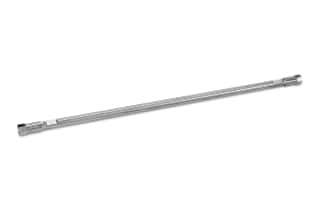
|
Chemistry |
Amino (NH2) |
|
Separation Mode |
Reversed Phase |
|
Particle Substrate |
Silica |
|
pH Range Min |
2 pH |
|
pH Range Max |
8 pH |
|
Maximum Pressure |
6000 psi (415 Bar) |
|
Particle Shape |
Spherical |
|
Particle Size |
10 µm |
|
Endfitting Type |
Waters |
|
Pore Size |
125 Å |
|
Format |
Column |
|
System |
HPLC |
|
USP Classification |
L8 |
|
Inner Diameter |
3.9 mm |
|
Length |
300 mm |
|
UNSPSC |
41115709 |
|
Application |
Carbohydrate |
|
Product Type |
Columns |
|
Units per Package |
1 pk |

The Amino NH2 Column is designed specifically for carbohydrate analysis, featuring a covalently bonded amino packing that excels in the separation of low molecular weight sugars such as mono-, di-, and trisaccharides. This column is a trusted choice for high-resolution carbohydrate profiling in complex sample matrices.
Optimized for use with a mobile phase typically consisting of 65-85% acetonitrile in water, the Amino NH2 Column provides reliable, reproducible separations under mild temperature conditions ranging from ambient up to 35° C. Its 125 Å pore size and 10 µm particle size make it particularly effective for detailed sugar analysis.
This column supports laboratories performing detailed sugar composition studies in fields such as food science, biotechnology, and pharmaceutical research. Its robust amino-based stationary phase offers strong retention and selectivity for carbohydrate species, making it ideal for both routine and research applications.
For compatible equipment and accessories, explore our full range of lab equipment designed to enhance your chromatography workflows.
Consider pairing the Amino NH2 Column with the XBridge BEH C18 Column for complementary separations in multi-analyte workflows.
What types of sugars can be separated using the Amino NH2 Column?
The Amino NH2 Column is ideally suited for separating low molecular weight sugars, including monosaccharides, disaccharides, and trisaccharides, providing clear and reproducible chromatographic resolution.
What mobile phase is recommended for this column?
A mobile phase typically comprising 65-85% acetonitrile in water is recommended. This helps achieve optimal retention and peak shape for carbohydrate analytes.
What is the typical operating temperature range for this column?
The column performs best at temperatures from ambient up to 35° C, ensuring consistent separation without compromising column integrity.
Is the Amino NH2 Column compatible with mass spectrometry (MS) detection?
Yes, when used with appropriate volatile mobile phases and sample preparation, this column can be integrated into LC-MS workflows for carbohydrate analysis.
How does the amino bonded phase improve carbohydrate separation?
The covalently bonded amino phase offers specific interactions with carbohydrate hydroxyl groups, enhancing retention and selectivity compared to other stationary phases.
What Are Examples Of Low Molecular Weight Sugars?
Many foods are made up of abundant and diverse carbohydrates, such as cereal, fruits, potatoes, flour, and vegetables. Carbohydrates are composed of carbon, hydrogen, and oxygen, and can exist as individual molecules or physically or chemically attached to other molecules. A monosaccharide is most often known as a simple, or low molecular weight, sugar. These serve as the building blocks for more complex forms of carbohydrates. This is the simplest form of carbohydrate. Examples include glucose, fructose, galactose, RNA, and DNA.